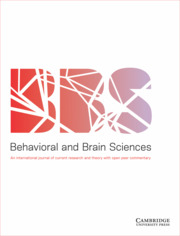No CrossRef data available.
Article contents
Evidence for LoTH: Slim pickings
Published online by Cambridge University Press: 28 September 2023
Abstract
In this commentary, I contend that a representative sample of the arguments in the target article miss the mark. In particular, the interface problem provides no warrant for positing similarities between representational formats, and the evidence from neurocognitive, animal, and behavioral studies is inconclusive at best. Finally, I raise doubts about whether the authors' central hypothesis is falsifiable.
- Type
- Open Peer Commentary
- Information
- Copyright
- Copyright © The Author(s), 2023. Published by Cambridge University Press
References
Arbib, M. A. (Ed.). (2003). The handbook of brain theory and neural networks. MIT Press.Google Scholar
Batterink, L., & Neville, H. J. (2013). The human brain processes syntax in the absence of conscious awareness. Journal of Neuroscience, 33(19), 8528–8533.CrossRefGoogle ScholarPubMed
Butterfill, S., & Sinigaglia, C. (2014). Intention and motor representation in purposive action. Philosophy and Phenomenological Research, 88(1), 119–145.CrossRefGoogle Scholar
Christensen, W. (2021). The skill of translating thought into action. Review of Philosophy and Psychology, 12, 547–573.CrossRefGoogle Scholar
Featherstone, C. R., Morrison, C. M., Waterman, M. G., & MacGregor, L. J. (2013). Semantics, syntax or neither? A case for resolution in the interpretation of N500 and P600 responses to harmonic incongruities. PLoS ONE, 8(11), 1–13.CrossRefGoogle ScholarPubMed
Firestone, C. (2020). Performance vs. competence in human–machine comparisons. Proceedings of the National Academy of Sciences of the United States of America, 117(43), 26562–26571.CrossRefGoogle ScholarPubMed
Mylopoulos, M., & Pacherie, E. (2017). Intentions and motor representations: The interface challenge. Review of Philosophy and Psychology, 8(2), 317–336.CrossRefGoogle Scholar
Pereplyotchik, D. (2017). Psychosyntax: The nature of grammar and its place in the mind. Springer.CrossRefGoogle Scholar
Sellam, T., Yadlowsky, S., Wei, J., Saphra, N., D'Amour, A., Linzen, T., … Pavlick, E. (2022). The MultiBERTs: BERT reproductions for robustness analysis, ICLR. [arXiv]. arXiv: arXiv:2106.16163.Google Scholar
van Gaal, S., Naccache, L., Meuwese, J. D. I., van Loon, A. A. M., Leighton, A. H., Cohen, L., & Dehaene, S. (2014). Can the meaning of multiple words be integrated unconsciously? Philosophical Transactions of the Royal Society, 369, 20130212.CrossRefGoogle ScholarPubMed




Target article
The best game in town: The reemergence of the language-of-thought hypothesis across the cognitive sciences
Related commentaries (30)
A language of episodic thought?
Advanced testing of the LoT hypothesis by social reasoning
Animal thought exceeds language-of-thought
Compositionality in visual perception
Concept learning in a probabilistic language-of-thought. How is it possible and what does it presuppose?
Developmental and multiple languages-of-thought
Do nonlinguistic creatures deploy mental symbols for logical connectives in reasoning?
Evidence for LoTH: Slim pickings
Incomplete language-of-thought in infancy
Is core knowledge in the format of LOT?
Is evidence of language-like properties evidence of a language-of-thought architecture?
Is language-of-thought the best game in the town we live?
Language-of-thought hypothesis: Wrong, but sometimes useful?
Linguistic meanings in mind
Linguistic structure and the languages-of-thought
Natural logic and baby LoTH
Neither neural networks nor the language-of-thought alone make a complete game
Never not the best: LoT and the explanation of person-level psychology
On the hazards of relating representations and inductive biases
Perception is iconic, perceptual working memory is discursive
Properties of LoTs: The footprints or the bear itself?
Putting relating at the core of language-of-thought
Representational structures only make their mark over time: A case from memory
Stop me if you've heard this one before: The Chomskyan hammer and the Skinnerian nail
The computational and the representational language-of-thought hypotheses
The language of tactile thought
The language-of-thought as a working hypothesis for developmental cognitive science
The reemergence of the language-of-thought hypothesis: Consequences for the development of the logic of thought
Toward biologically plausible artificial vision
Using the sender–receiver framework to understand the evolution of languages-of-thought
Author response
The language-of-thought hypothesis as a working hypothesis in cognitive science